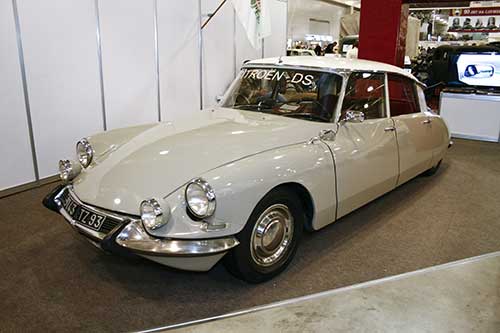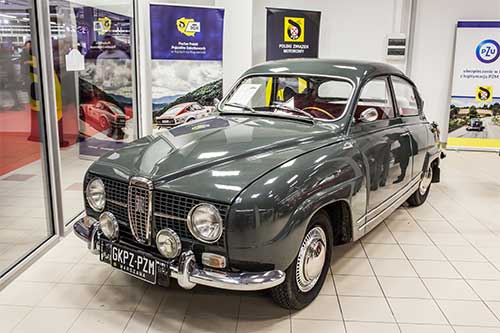The Economics of Automobile Safety
Early-production Citroën DS with hydropneumatic suspension. The DS was launched in 1955, and continued for 20 years.
The 1950s and ‘60s were defining decades in the evolution of automotive safety in the United States. Prior to the ‘50s, little thought was given by the industry to passively protecting passengers in the event of a crash. But despite resistance from the American auto industry, safety eventually won out, by popular demand of the U.S. consumer.
Some auto manufacturers’ names evoke a visceral sense of safety. SAAB, Volvo, Citroën, Mercedes, Rover and others devoted much of their energies to designing and building cars that were both inherently safe and crash-worthy.
You’ll notice that these cars and their makers all hail from Europe. Their influence upon critical U.S. auto safety design and application cannot be overlooked. SAAB had been building military aircraft and incorporated some of the design features into their cars. Volvo built engines and military vehicles for the Swedish government during World War II.
Volvo engineer Nils Bohlin had spent much of his career in aviation, and used techniques learned in that industry to develop the three-point safety belt that would cover the driver’s torso and lap, essentially creating the seat-belt system found in almost all passenger cars today. Mercedes created crumple zones; SAAB developed a safety cage and dual diagonal braking; Citroën had its unibody construction, unique hydropneumatic self-leveling suspension, disc brakes and Michelin radial tires. European cars were at the forefront of safety technology.
After my life flashed before me during an accident with a Mini (yes, also from Europe but designed as a city car), safety was paramount in any car buying decision. In late 1974 I was without transportation, or for that matter, much money. I opened my wallet and two twenties fluttered to the table.
I picked up the newspaper and after a few minutes of searching, found an ad for a 1966 SAAB 96 two-stroke. I knew little about SAABs (Svenska Aeroplan Aktiebolaget), but what I did know was that safety was an essential part of its brand. The two-stroke was advertised at a budget crushing price of $70. Undeterred, I rang the number and was told the car was available and could be seen immediately.
Borrowing my Dad’s Volvo, I drove the three miles into town to have a look. It was mole grey and somewhat forlorn, with the driver side “B” pillar pushed in from what looked to be a recent accident. I did a quick reconnoiter and didn’t see rust or a reason to reconsider. I figured I could fix the damage, and after the owner talked himself down from the initial $70 to $40, I handed over the money. I picked up the SAAB the next day, and very quickly came to appreciate the design ethic and its surefootedness in waist-deep snow. Over the next twelve years I owned a number of SAABs, all second- (or third-) hand.
It took some time for U.S. consumers to catch on to the virtues of safe, if more expensive, vehicles. In this country, the challenge of incorporating safety equipment was initially seen neither as a betterment of society through auto safety nor an inevitability. It was piecemeal at best, and it was Preston Tucker and his Tucker 48 (not one of the big three) that introduced safety belts and padded dashboards to American roads, albeit in very limited numbers, in the late 1940s.
Ford, Nash, Chrysler and Buick offered seat belts as optional equipment during the 1950s. For the 1956 model year, Ford offered to pad the dashboard and install seat belts for any consumer willing to pay an additional $27. Very few customers signed up. Ford eventually succumbed to complaints from a GM executive that the safety focused ads took the romance out of the car business.
In the 1950s, GM was refusing to offer seat belts, saying there was no conclusive evidence that the belts helped prevent auto injuries. Ford decided to focus on styling and performance rather than safety. While dealers certainly didn’t push them, and while safety experts claimed it would only cost 50 cents to install mounts so drivers could add the belts themselves, U.S. manufacturers just weren’t interested.
In November of 1965, “Unsafe at Any Speed: The Designed-In Dangers of The American Automobile” was published. Written by Ralph Nader, the groundbreaking book castigates U.S. car builders for their systemic resistance to the introduction of safety features.
Its first chapter is titled “The Sporty Corvair.” It details the design of the first iteration (‘60 – ‘64) Chevrolet and its swing-axle rear suspension, which was suspected of causing instability under certain driving conditions.
Even before the release of the book, the industry did show a willingness to change. Chevy modified the swing axle for the 1964 model, and in 1965 it was completely redesigned to a fully independent rear suspension maintaining a constant camber angle. This allowed the rear wheels to continually remain parallel to the road surface. Ultimately, because of its shortcomings, the swing axle was replaced industry-wide in the United States by the fully independent suspensions that are commonplace today.
There were also times when changes were needed but nothing was done. The Ford Pinto, with its propensity for bursting into flames during low-speed rear-end collisions, is one example.
Over time, Americans came to value the safety offered by European cars, and the domestic industry had to play catch-up. Through public awareness and acceptance, things began to change. In 1966, the National Traffic and Motor Vehicle Safety Act was ratified. The act mandated federal safety standards for motor vehicles and empowered the federal government to set and administer new safety standards. Changes in both vehicle design and driver behavior began to reduce crashes and injuries.
In the U.S. we still lose far too many people to automotive-related deaths. The latest available number, for 2015, is just above 35,000, but that was 20,000 fewer per year than in the early 1970’s, and it is certainly headed downward as the application of technology to the design and construction of cars continues, with safety as its overarching goal.
Ultimately the U.S. car buying public was offered and accepted safer cars, and was willing to pay a somewhat higher price for the inclusion of these safety features. The process was generally evolutionary over a period of many years, but it reached a critical mass in the late 1950’s and 1960’s. Once consumers realized the true benefits of safety equipment in cars, there was no going back to a simpler, carefree time.
Sixties-era SAAB 96 had dual diagonal brakes.










